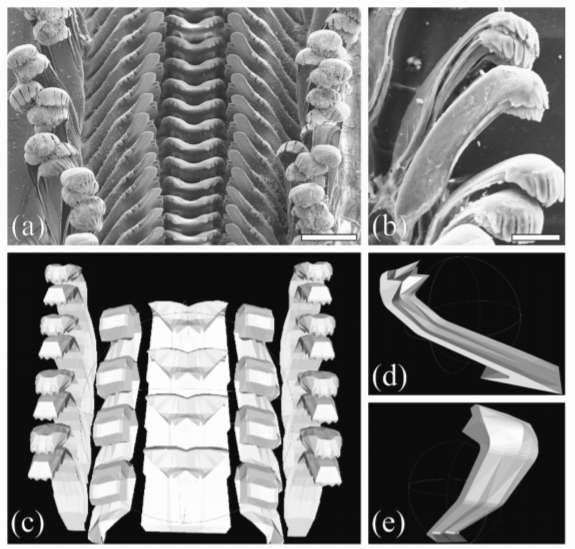Journal of Bionic Engineering (2025) 22:1364–1380https://doi.org/10.1007/s42235-025-00666-z
The Influence of the Collective Effect of Tooth–tooth Interaction on the Feeding Efficiency of Gastropods: A Biomimetic Approach
Wencke Krings1,2,3,4 · Tamina Riesel2 · Thomas M. Kaiser2 · Alexander Daasch2 · Ellen Schulz-Kornas1 · Stanislav N. Gorb4
1 Department of Cariology, Endodontology and Periodontology, University of Leipzig, Liebigstra?e 12, 04103 Leipzig, Germany
2 Section Mammalogy and Palaeoanthropology, Leibniz Institute for the Analysis of Bioaffiliationersity Change, Martin-Luther-King-Platz 3, 20146 Hamburg, Germany
3 Department of Electron Microscopy, Institute of Cell and Systems Biology of Animals, University of Hamburg, Martin-Luther-King-Platz 3, 20146 Hamburg, Germany
4 Department of Functional Morphology and Biomechanics, Zoological Institute, Kiel University, Am Botanischen Garten 1–9, 24118 Kiel, Germany
Abstract
The radula is a crucial adaptation for food-processing in molluscs. A deeper understanding of the interaction between the radula and the preferred food is lacking, complicating the inference of the precise ecological roles of radular structures. This study presents the first experimental set-up that allows to study the influence of the radular morphology, specifically the degree of tooth-tooth interlocking (so-called collective effect), on the feeding efficiency. For this purpose, physical 3D models of the teeth were designed using CAD software and 3D printing technique. The feeding efficiencies with models of different degree of interlocking were determined by tensile tests, pulling the models trough agar gels with different viscosities. The forces generated by the models and the masses of the removed gel fragments were determined. We found, that radular models with a high degree of tooth–tooth interlocking performed best as they were able to remove most agar. We additionally broke the teeth and determined, that the teeth with the highest degree of interlocking could resist to highest force. Overall, the study highlights the complex interplay between radular morphology and its ecological function, suggesting that even minor morphological alterations can significantly impact the efficiency and effectiveness of food gathering. Understanding these interactions cannot only shed light on the ecological adaptations of molluscs, but provide further insights into development of more effective grinding, scraping, and cleaning technical devices.
Keywords Mollusca · Feeding · Mechanical behaviour · Breaking stress · Tensile test · 3D printing

Copyright © 2025 International Society of Bionic Engineering All Rights Reserved
吉ICP备11002416号-1









